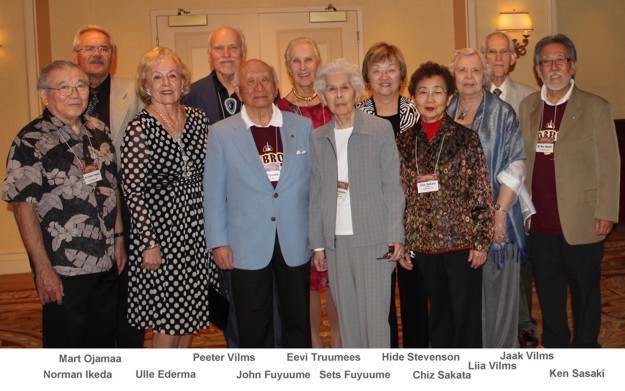
A Seabrook reunion was held at the Golden Nugget in Las Vegas Oct. 7 – 8, 2013. The reunion was organized and hosted by an active group of Japanese Americans. The reunion committee included Fumio Ikeda, Ken and Sally Sasaki, Ann Lowe, Chris Hada, Chiz Hada Sakata, Hide Stevenson, Norman Fumio Ikeda and several others.
About 130 participants came from all over the United States. Present was also a small group of Estonians who were invited to participate for the first time. At one point in time, there was an active Estonian community in Seabrook living and working side by side with the Japanese community. Seabrook is part of Upper Deerfield Township in Cumberland County, New Jersey. Over decades, many ethnic groups had settled there.
Before 1940, many groups of various ethnic origins were employed by Seabrook Farms, a food processing plant which was considered to be essential to the war effort. It provided shelter for its workers; the housing project of Upper Deerfield Township provided most of the needs of the people living there. The population in the area grew rapidly.
Earlier ethnic groups in the township were Germans, Dutch, Italians and Swedes. Greeted unfavorably as newcomers to Seabrook Farms and Cumberland County at large, they were, nevertheless, followed by the Poles, Jamaicans, as well as the Japanese in the 1940’s. In the beginning, many endured discrimination and prejudice, however, today they are recognized as an influential and a highly respected part of the township. The abovementioned ethnic groups were later followed by Estonians, Latvians, and Lithuanians.
As previously mentioned, in 1944 and during the years that followed, hundreds of people of Japanese ancestry joined the population of the Seabrook community. Their rich heritage dates back a thousand years earlier than that of the Roman civilization. Upon invitation by C. F. Seabrook, some 600 families involving more than 2500 individuals came from their “relocation centers” to work at Seabrook Farms. They came to make a new life here following their release from internment camps. Over the years, they have brought favorable recognition to the Seabrook community and still have a positive impact there. They are even today an integral part of the community.
Through intensive work of Estonian Consul General Johannes Kaiv and Consul Ernst Jaakson, Congress enacted legislation in 1948 that opened America’s doors to a quota of displaced persons in Germany. Charles F. Seabrook, the owner of the vegetable processing factory of Seabrook Farms, guaranteed housing and jobs for about 600 Estonians . In 1949, Estonians began to arrive in Seabrook. Their first homes were 66 prefabricated barracks that had been built earlier to house Japanese workers. That was a traumatic and bitter experience for everyone concerned. As months and years passed, the Estonian community displayed a remarkable ability to adapt. Through diligence and frugality, their standard of living improved by leaps and bounds. Estonians earned a favorable reputation in the community at large for their mastery of the English language, their singing traditions as well as for their folk dances. Colorful Estonian folk costumes and intricate handicrafts were an inspiration for everyone. Estonian students constantly ranked highest in their graduating classes. The achievements of Estonians have been outstanding. It needs to be said that the Japanese American students did also exceptionally well on all levels of schooling.
As a footnote of Estonian charm: C. F. Seabrook was enamored by Estonians. He was especially inspired by the Estonian choir who had established a tradition of serenading him on the eve of his birthday. How can you not be impressed when one of your truck drivers during the day donned evening clothes and sang operatic tunes at your parties at night! This was Heinz Riivald.
Today the Estonian community in Cumberland County has become much smaller and somewhat dispersed. The Seabrook Estonian Association, led by Eevi Truumees, is still active, they always come together to celebrate the Estonian Independence Day. There are services twice a month in the Northville Estonian Lutheran Church. There was a memorable gathering at a gala to celebrate the 50th anniversary of Estonians in Seabrook and a smaller celebration on the 60th anniversary. Even today many people who once called Seabrook “home” retain a nostalgic memory of their life there.
The reunion in Las Vegas brought together some childhood friends among Japanese Americans and Estonians. Many had a chance to get reacquainted with former schoolmates, make new friends, or share common childhood experiences in this unique place called Seabrook.
The reunion activities were well planned. Registration and an informal buffet dinner were on the agenda on the first day. After a delicious dinner, lively conversation ensued. The second day was a day at leisure to enjoy sightseeing or trying one’s luck at gambling. A formal banquet on the last evening with an interesting program ended the festivities. The participants were entertained by humorous anecdotes of growing up in Seabrook. On a more serious note, some of the Japanese and Estonian members of the Seabrook community were recognized for their outstanding contribution to the community over the years. Among the honorees were 4 Estonians. Peeter Vilms announced the Estonian honorees : Albert Vilms (posthumously) for his leadership in the Estonian community; Eevi Truumees – a longtime member of the executive board of the SECC; Emmi Bajars – for her work at the SECC; and Juhan Simonson (posthumously) – a longtime president of the EANC, serving the Estonian community at large. John Fuyume, the former director of the SECC, recognized volunteers who have contributed to the success of the Cultural Center. A photography session drew the evening to a close.
A good time was had by all. The Estonians were especially thankful to the reunion committee for having been invited to this memorable event.
Ülle Ederma
Statistics from “This Place Called Home” by F. Alan Palmer.
















